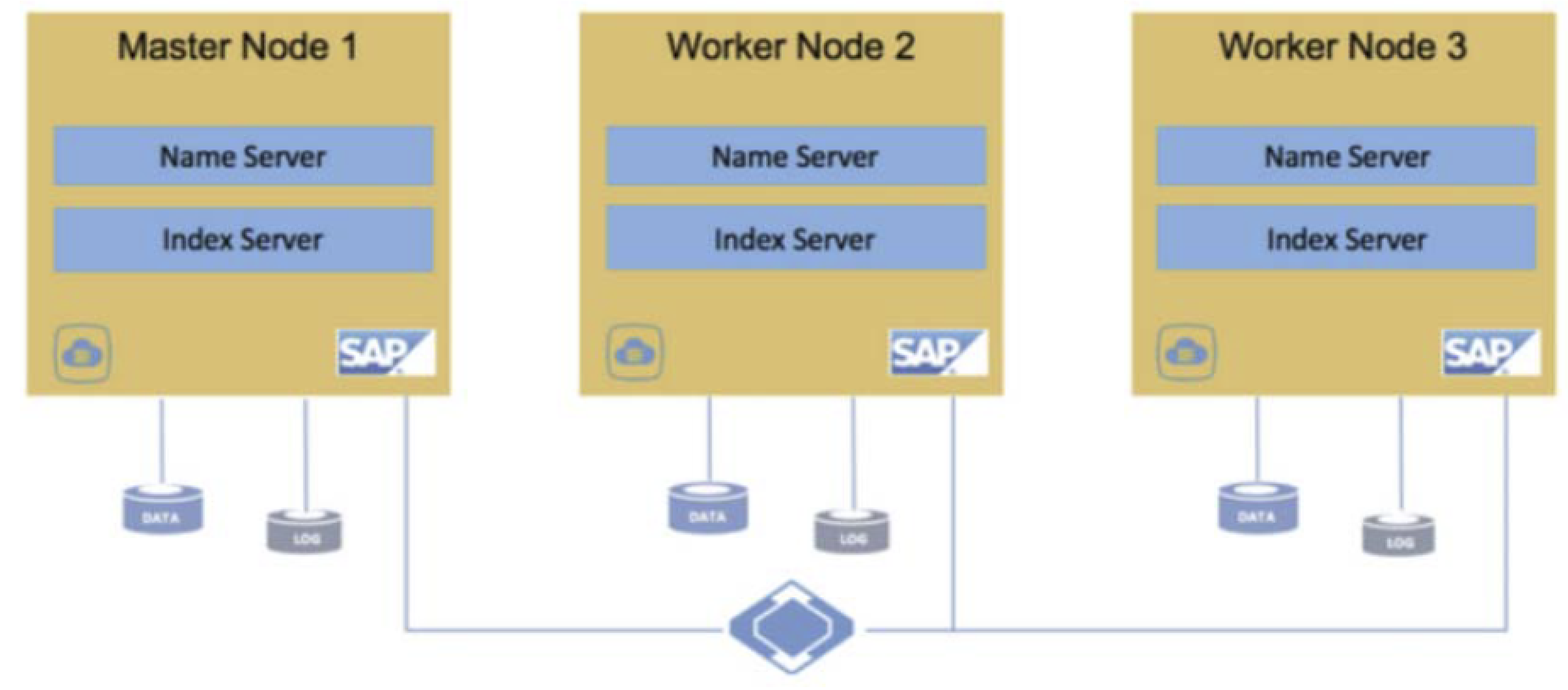Auf dieser Seite finden Sie Informationen zum Schutz von HANA 1+n und HANA-Scale-out.
HANA 1+n schützen
Um einen HANA-Cluster mit 1+n-Replikation als einzelne Anwendung zu schützen, hat die Anwendung nach der Anwendungserkennung den Clusterhost als SID name_cluster. Wenn sr1 beispielsweise die HANA-Instanz ist, lautet der Anwendungsname sr1 und der Hostname sr1_cluster in der Liste App Manager Applications (App Manager-Anwendungen).
Das Ziel für die HANA-Logsicherung muss für zwei Knoten freigegeben sein. Bei einem Failover werden die Datenbank- und Logsicherung automatisch auf den aktuellen primären Knoten übertragen. Logsicherungen werden vom aktuellen primären Knoten aus durchgeführt. Dabei werden die letzten Logs vom alten primären Knoten sowie neue Logs vom neuen primären Knoten erfasst. Führen Sie die Vorbereitungsschritte unter SAP HANA-Datenbanken für den Schutz vorbereiten aus.
HANA 1+n wird immer als Clusteranwendung mit allen Knotendetails in den Metadaten erkannt. Es empfiehlt sich, nach Änderungen an der Konfiguration von Clusternknoten, z. B. nach dem Hinzufügen oder Löschen eines Knotens aus dem Cluster, eine erzwungene Erkennung auszuführen. Wenn ein Knoten nach der Erkennung und dem Schutz entfernt oder hinzugefügt wird, wird die Konfiguration nicht automatisch in den Backup and DR-Metadaten aktualisiert. Dies kann zu Problemen bei der Sicherung führen.
Voraussetzungen für den Schutz von SAP HANA-Instanzen und ‑Datenbanken (1+n)
Bevor Sie SAP HANA-Instanzen schützen, müssen Sie Folgendes sicherstellen:
- Wenn für Hosts virtuelle IP-Adressen konfiguriert sind, fügen Sie bei der Erkennung nur die virtuelle IP-Adresse und den Hostnamen des primären Hosts hinzu.
- Der Backup and DR-Agent muss auf allen Knoten installiert sein.
- Auf den Hosts müssen Ports geöffnet werden, damit die Kommunikation über Port 5106 möglich ist. Dazu ist eine Firewallregel für eingehenden Traffic erforderlich, bei der die Sicherungs-/Wiederherstellungs-Appliance die Quelle, der Host, auf dem der Agent ausgeführt wird, das Ziel und der Zielport 5106 ist. Außerdem muss Port 5106 nicht der standardmäßigen Ingress-Regel hinzugefügt werden, die für die Appliance erstellt wurde, da die Appliance als Ziel angegeben ist.
- Der Speicherort für HANA-Logsicherungen muss auf „shared“ (freigegeben) – NFS festgelegt sein.
HANA-System mit horizontaler Skalierung schützen

Voraussetzungen für den Schutz von SAP HANA-Instanzen mit horizontaler Skalierung
Bevor Sie SAP HANA-Instanzen mit horizontaler Skalierung schützen, müssen Sie Folgendes erledigen:
- Wenn für Hosts virtuelle IPs konfiguriert sind, fügen Sie bei der Erkennung nur die virtuelle IP und den zugehörigen Hostnamen des primären Hosts hinzu.
- Der Backup and DR-Agent muss auf allen Knoten installiert sein.
- Auf den Hosts müssen Ports geöffnet werden, damit die Kommunikation über Port 5106 möglich ist. Dazu ist eine Firewallregel für eingehenden Traffic erforderlich, bei der die Sicherungs-/Wiederherstellungs-Appliance die Quelle, der Host, auf dem der Agent ausgeführt wird, das Ziel und der Zielport 5106 ist. Außerdem muss Port 5106 nicht der standardmäßigen Ingress-Regel hinzugefügt werden, die für die Appliance erstellt wurde, da die Appliance als Ziel angegeben ist.
- Für die Backint-Datei-basierte Sicherung (Vollständig + Inkrementell) muss der HANA-Protokollsicherungsort auf „Freigegeben“ (NFS) festgelegt werden. Weitere Informationen finden Sie unter Host in der Verwaltungskonsole hinzufügen.
Schutz von Speichersnapshots
- Daten- und Logvolumen werden nicht auf alle Knoten verteilt.
- Daten- und Log-Volumes werden vom Logical Volume Manager (LVM) verwaltet.
- Prüfen Sie, ob die Verzeichnisse mnt000* auf den lokalen Mount-Punkten vorhanden sind, um die primären und sekundären Knoten zu identifizieren.
Folgen Sie der Anleitung unter SAP HANA-Datenbanken für den Schutz vorbereiten.
Backup and DR Service-Dokumentation für SAP HANA-Systeme mit horizontaler Skalierung
Diese Seite ist eine von mehreren Seiten, die sich speziell mit dem Schutz und der Wiederherstellung von SAP HANA-Instanzen mit horizontaler Skalierung mit dem Backup- und DR-Dienst befassen. Weitere Informationen finden Sie auf den folgenden Seiten:
- Backup and DR für SAP HANA-Systeme mit horizontaler Skalierung
- SAP HANA-Scale-out-Instanzen für die Sicherung vorbereiten
- SAP HANA-Host mit horizontaler Skalierung hinzufügen und seine Datenbanken erkennen und schützen
- Staging-Laufwerkformat und Sicherungsmethode für SAP HANA-Scale-out konfigurieren
- Anwendungsdetails und -einstellungen für SAP HANA-Scale-out-Instanzen festlegen
- HANA 1+n- und HANA-Datenbanken mit horizontaler Skalierung sichern
- SAP HANA-Instanzen mit horizontaler Skalierung wiederherstellen
- SAP HANA-Backup mit horizontaler Skalierung als Standardmount bereitstellen
- SAP HANA-Sicherung mit horizontaler Skalierung als virtuelle Datenbank einbinden
- SAP HANA-Scale-out-Sicherung für die sofortige Wiederherstellung auf einem beliebigen Ziel bereitstellen und migrieren

